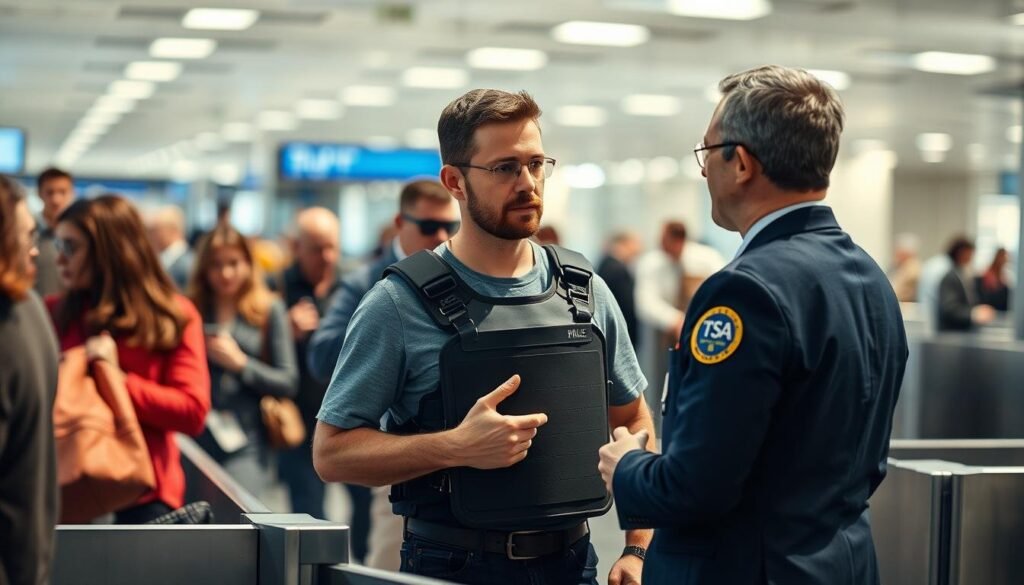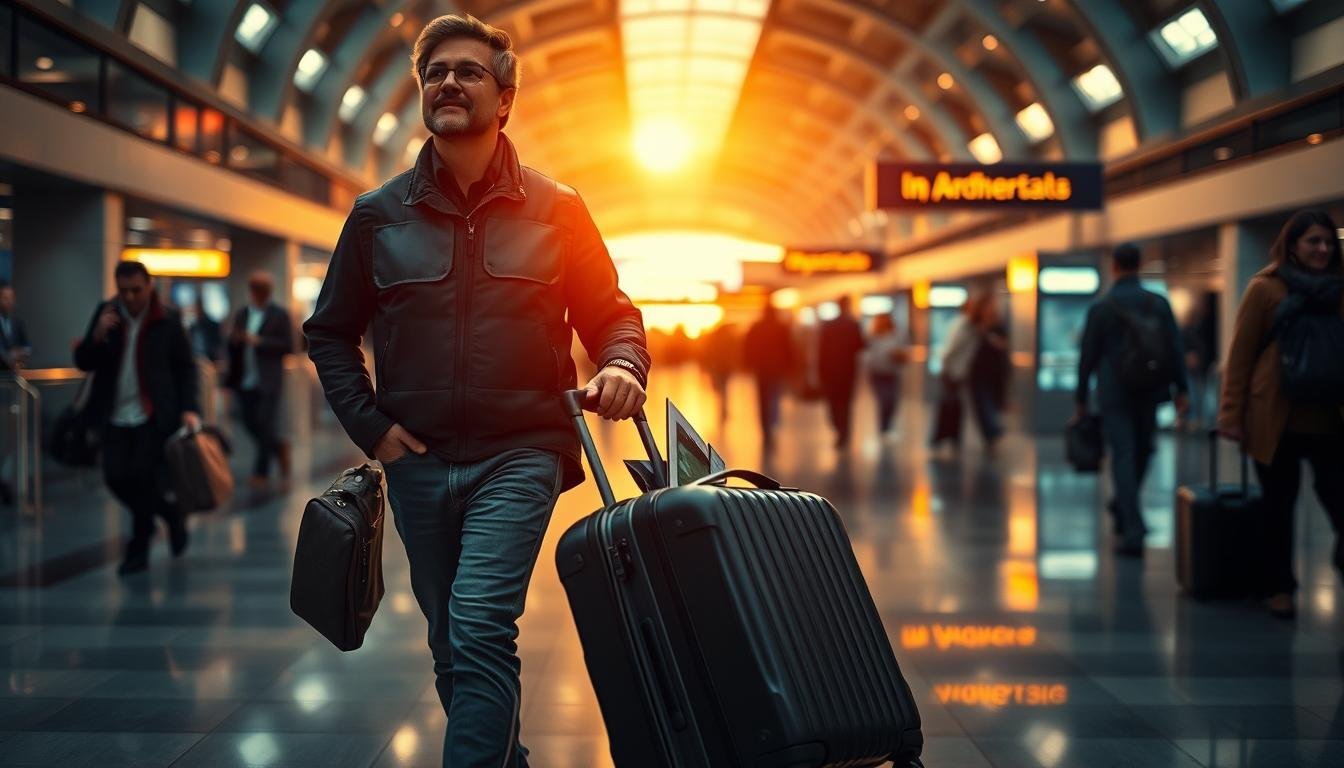Bringing Armor Plates on Flights: Traveling with body armor can be a worry for many. If you’re curious about the rules for bringing armor plates on a flight, you’re in the right spot.
This guide will cover the rules and tips for carrying armor plates on a plane. Knowing these guidelines is key for a hassle-free trip.
Whether you travel often or just need to move your protective gear, understanding what to expect is important. Let’s explore the details to help you prepare for your next flight.
Contents
- 1 Understanding Body Armor and Armor Plates
- 2 TSA Regulations: Can You Bring Armor Plates on a Plane?
- 3 How to Properly Pack Armor Plates for Air Travel
- 4 Declaring Body Armor at Airport Security
- 5 Legal Considerations Beyond TSA Rules
- 6 International Travel Considerations with Armor Plates
- 7 Conclusion: Bringing Armor Plates on Flights
- 8 FAQ
- 8.1 Can I bring armor plates on a domestic flight within the United States?
- 8.2 Are there any specific requirements for packing armor plates for air travel?
- 8.3 Do I need to declare my body armor at airport security checkpoints?
- 8.4 Can I bring armor plates on an international flight?
- 8.5 Are there any restrictions on carrying body armor if I have a felony conviction?
- 8.6 Can law enforcement officers bring armor plates on flights while on duty?
Understanding Body Armor and Armor Plates
When thinking about personal protection, it’s key to know about body armor and armor plates. Body armor is made to shield you from different dangers, like handgun rounds and rifle fire.
Soft vs. Hard Armor Plates
Body armor has two main types: soft and hard. Soft armor, made from materials like Kevlar, guards against handgun rounds. Hard armor, with its rigid plates, protects against rifle rounds and other fast-moving threats.
The National Institute of Justice (NIJ) sets standards for body armor protection levels. These levels go from Level IIA (protects against 9mm rounds) to Level IV (protects against armor-piercing rifle rounds). Knowing these levels helps you pick the right armor for your needs.
| NIJ Level | Protection Against |
|---|---|
| Level IIA | 9mm rounds |
| Level II | 9mm and .357 Magnum rounds |
| Level IIIA | .357 SIG and .44 Magnum rounds |
| Level III | Rifle rounds (up to .308 caliber) |
| Level IV | Armor-piercing rifle rounds |
Military and Law Enforcement Applications
Body armor is vital for military and law enforcement, who face dangerous situations. They use body armor to defend against handgun rounds and rifle fire.
Civilian Personal Protection Needs
Civilians also need body armor, especially those in risky jobs or living in crime-prone areas. Knowing your protection needs and choosing the right body armor can give you peace of mind and might save your life.
TSA Regulations: Can You Bring Armor Plates on a Plane?
Many people ask if they can bring armor plates on a plane. The answer is in TSA regulations. The Transportation Security Administration (TSA) has rules for carrying armor plates on airplanes.
The TSA lets passengers carry body armor, like armor plates, in both carry-on and checked luggage. But, there are some rules and restrictions.
Permitted vs. Prohibited Materials
What materials armor plates are made of matters. Soft body armor from Kevlar is usually okay. But, hard or rigid materials might need extra checks or could be banned.
Special Considerations for Enhanced Plates
Enhanced armor plates, with materials like ceramic or metal, follow the same TSA rules as other body armor. It’s important to tell security about these items to avoid problems.
Weight and Size Restrictions
The TSA doesn’t set limits on weight and size for armor plates. But, they must be packed for easy screening. Large or heavy items might need special care.
Airline-Specific Policies
Airlines also have their own rules about body armor and armor plates. Always check with your airline before you travel to make sure you follow their rules.
| Airline | Policy on Armor Plates | Additional Requirements |
|---|---|---|
| American Airlines | Allowed in checked luggage | Must be declared at check-in |
| Delta Air Lines | Allowed in both carry-on and checked | Subject to additional screening |
| United Airlines | Allowed in checked luggage | Must be packed in a protective case |
Knowing these rules and airline policies can make traveling with armor plates easier.
How to Properly Pack Armor Plates for Air Travel
To travel with armor plates, you must pack them correctly to pass through airport security smoothly. Proper packing ensures your armor plates arrive undamaged. It also helps follow airline and TSA rules.
Protective Cases and Covers
Start by using a protective case or cover for your armor plates. These cases protect the plates and show they are body armor. Choose cases made for body armor for the best protection.
Securing Plates Within Luggage
After putting your armor plates in a protective case, secure them in your luggage. Wrap the case in clothes or use packing materials to keep it still. Make sure the plates don’t move during travel to avoid damage or security issues.
Having proof of ownership and why you need the armor plates helps during security checks. This can include a letter from your employer or a purpose explanation. Being ready can help avoid problems.
Manufacturer Specifications and Certifications
Keep your armor plates’ manufacturer specs and certifications with you. These documents prove the plates are real and of good quality. Carry them when you travel.
By following these steps, you can pack your armor plates right for flying. This reduces the chance of damage or travel issues.
- Use protective cases designed for body armor.
- Secure the plates within your luggage.
- Carry proof of ownership and purpose.
- Keep manufacturer specifications and certifications handy.
Declaring Body Armor at Airport Security
Knowing how to declare body armor at airport security can make your trip easier. When you bring body armor to the airport, being ready for security checks is key.

Talk clearly to security staff about your body armor. Tell them you have body armor and be ready to share more if they ask.
Answering Common Questions
Security might ask about your body armor, like its use, material, or if it’s been worn. Always be truthful and help with any documents or info they need.
Manual Inspections and Swab Tests
Security might check your body armor by hand or do a swab test. Always follow these steps to avoid any hold-ups.
Dealing with Security Concerns
If security has doubts about your body armor, stay calm and explain its use. Showing proof or certification can help clear up any worries and speed up the check.
| Security Protocol | Description | Recommended Action |
|---|---|---|
| Declaration | Informing security about body armor | Be clear and concise |
| Manual Inspection | Physical examination of body armor | Cooperate fully |
| Swab Test | Checking for suspicious substances | Allow the test to be conducted |
Legal Considerations Beyond TSA Rules
TSA rules set a basic standard for what you can bring on a flight. But, the laws around body armor are more complex. You need to look at different legal points to make sure you follow the rules when you travel with armor plates.
Restrictions for Convicted Felons
If you’ve been convicted of a felony, you should know that laws about body armor are different. In many places, people with felony convictions can’t have body armor.
State-to-State Variations
Body armor laws change a lot from state to state. Some places have very strict rules, while others are more relaxed. It’s important to know the laws in the state you’re going to.
Police officers usually have special rules to carry body armor, even in places with strict laws. But, you need to check the exact rules for your department and area.
Civilian Rights and Restrictions
Civilians have different rights to body armor, based on where they are. It’s key to know these rights and any limits that apply to you.
| Category | Restrictions | Special Considerations |
|---|---|---|
| Convicted Felons | Prohibited from possessing body armor in many jurisdictions | Check local laws for specifics |
| Law Enforcement | Special permissions often apply | Verify departmental and jurisdictional guidelines |
| Civilians | Varying rights and restrictions by jurisdiction | Understand local laws and regulations |
It’s crucial to understand these legal points for safe and legal travel with body armor. Always do your research and follow the laws of your destination.
International Travel Considerations with Armor Plates
Before you travel internationally with armor plates, learn about the laws where you’re going. Traveling with body armor can be tricky because laws vary by country.
It’s important to know these laws to avoid trouble or losing your armor plates. Here are some things to keep in mind:
- Research the laws of your destination country regarding body armor.
- Understand the requirements for declaring body armor at international borders.
- Be aware of countries with complete prohibitions or special permit requirements.
Nations with Complete Prohibitions
Some places ban body armor imports completely. For example, some European and Asian countries don’t allow it. Make sure your destination isn’t one of them.
Countries with Special Permit Requirements
Other countries need special permits for body armor imports. For example, Canada and Australia have specific regulations that may necessitate a permit for certain types of body armor. Know these rules before you go.
When you cross borders, you might need to say you have body armor. Not telling can lead to it being taken away or legal trouble. Be ready to talk about your armor, like what it’s made of and why you have it.
Potential Confiscation Scenarios
Even if you declare your body armor, it might still be taken if it breaks local laws. Knowing the laws can help you avoid or prepare for this.
Being informed and ready can make traveling with armor plates easier. Always check the latest laws before you go to follow them.
Conclusion: Bringing Armor Plates on Flights
When you plan to bring armor plates on a flight, knowing the rules is key. Armor plates have specific rules, especially from the Transportation Security Administration (TSA).
To travel with armor plates, pack them right, declare them at security, and know the legal stuff. If you’re going abroad, learn about your destination’s laws too.
Following this guide will make your trip easier with armor plates. Always check the TSA’s site for updates on body armor and plates. This keeps you in the loop about flying with armor plates.
See Also: irsoft Guns on Planes: Your Guide to Proper Transport
FAQ
Can I bring armor plates on a domestic flight within the United States?
The TSA says you can bring armor plates on a domestic flight. But, they must be packed right and declared at security.
Are there any specific requirements for packing armor plates for air travel?
Yes, the TSA suggests using a protective case or cover for your armor plates. This helps prevent damage and makes screening easier.
Do I need to declare my body armor at airport security checkpoints?
Yes, tell the TSA officer at the checkpoint about your body armor. This can prevent confusion and delays.
Can I bring armor plates on an international flight?
International flight rules on body armor vary. Always check the laws of your destination countries before bringing armor plates.
Are there any restrictions on carrying body armor if I have a felony conviction?
Yes, people with felony convictions might face body armor restrictions. It’s important to know the laws in your state and any you plan to visit.
Can law enforcement officers bring armor plates on flights while on duty?
Law enforcement might not face all body armor restrictions. Still, they should confirm with their agency and the TSA about their specific rules.

Hello, I’m Janiyah Gibbs—a retired flight crew member and former TSA officer from Alaska, USA. At PlaneCarry.com, I share expert insights on what to carry (and avoid) when flying.

